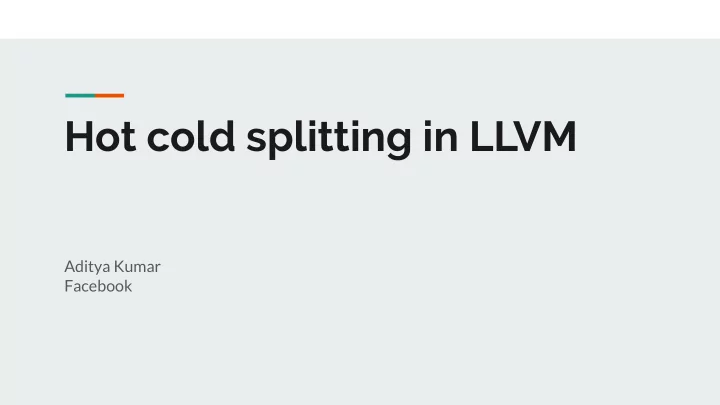

Hot cold splitting in LLVM Aditya Kumar Facebook
[] How does the density of an object affect its ability to float? ... With apologies to the Tweeter...
“... but, yet, it's one of the most interesting things that happened in the LLVM optimizer this year.” Anonymous Reviewer
Hot cold splitting Intro ● Regions ● Marking Edges ● Propagating Profile Info ● Extracting maximal region ● Experimental Results ● Opportunities for improvement ●
Regions 1. SESE 2. SEME SEME SESE Image source: https://upload.wikimedia.org/wikipedia/commons/3/30/Some_types_of_control_flow_graphs.svg
Converting SEME to SESE
Marking Edges Using static analysis ● e.g., __builtin_expect, assertions, non-returning functions, ○ catch-block Using dynamic profile information ●
Propagating Profile Info Using dominance and post-dominance ● CFG of ‘ foo ’
Extracting cold region 1. Find maximal region 2. Compute inputs outputs 3. Extract as function 4. Add attributes CFG of CFG of noinline, minsize, cold ○ ‘ foo ’ ‘ foo.cold.1 ’
Design decisions ( implementing in the middle end ) Advantages Drawbacks Focus on the optimization and tuning Architecture specific opportunities Optimize cold functions for size Take advantage of (thin)LTO Helps all backend targets Low maintenance overhead
Applications benefitting from HotColdSplitting High icache misses - Code with lots of branches - Smaller page size High premain time - Reduce startup working set
Experiment Evaluation Experimental setup - 2 step build with PGO or AutoFDO Measurements - Measure pre-main metrics e.g., page faults - iCache misses ( perf stat -e icache.misses ) - Field data - Code size
Execution time LLVM Testsuite
Code size LLVM Testsuite
LLVM-testsuite (# of functions outlined) LLVM Testsuite
LLVM testsuite (perf stat*) * perf stat -e instructions,icache.misses (try `perf list` to find out other metrics of interest)
Impact 1. Enabled in Xcode, swift-llvm 2. ios-13 shipped with hot cold splitting enabled All core libraries e.g., libc++, libSystem, dyld, CoreFoundation, UIKit, SSL ○
Opportunities for improvement 1. Concepts of hot-cold 2. Outlining maximal regions 3. Improving static analysis 4. Improving Code Extractor 5. Tuning cost model for code-size 6. Merge Similar Function meets Hot Cold Splitting 7. Outlining regions post-dominated by non-returning function calls (D69257)
Concepts of hot-cold partitioning Hot = interesting - Randomly outlining code - https://reviews.llvm.org/D65376 Cold = not interesting - Hard coding custom sub-graphs - Or pass as compiler flags
Outlining maximal regions
Merge Similar Function + Hot Cold Splitting Schedule MergeSim after HotColdSplit - May improve code-size with appropriate cost model * Repaired the port of merge-similar-functions (MergeSim) to thinLTO https://reviews.llvm.org/D52896
Performance
Codesize
Acknowledgements $ c++filt __Z3fooi Vedant Kumar foo(int) Sebastian Pop $ c++filt __Z3fooi.cold.1 Teresa Johnson foo(int) (.cold.1) Sergey Dmitriev $ c++filt __Z3fooi_cold Krzysztof Parzyszek __Z3fooi_cold References: https://reviews.llvm.org/D50658 http://lists.llvm.org/pipermail/llvm-dev/2019-January/129606.html
Possible questions How does Hot Cold splitting perform in absence of profile information, i.e. using only ● static analysis? Depends on programmer annotations and programming-language features ○ ○ Only 280 functions outlined in llvm without profile information. Is this optimization now mature enough to be ON by default with PGO? ● ○ Issues with AssumptionCache, and CodeExtractor: PR40710, PR43424 Difference in performance for C vs C++ applications? ● ○ Try-catch blocks Interaction with code layout optimization which reorder hot/warm BBs to reduce ● instruction cache misses Reordering doesn’t change dominance ○ ● Debuginfo support for this optimization Reasonable? ○ ● How to reduce code-size growth Tune the number of function arguments to be created while splitting ○
Recommend
More recommend